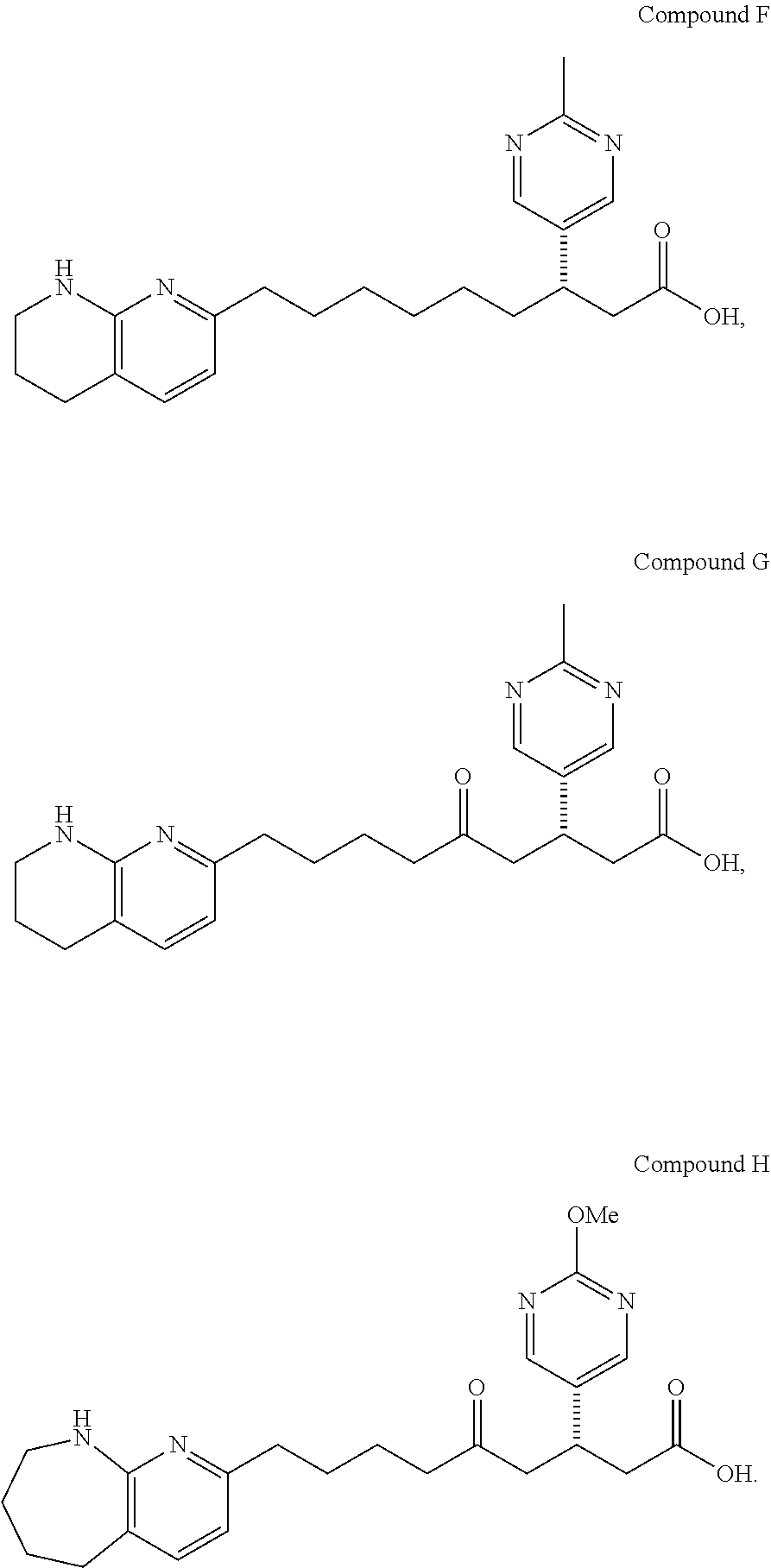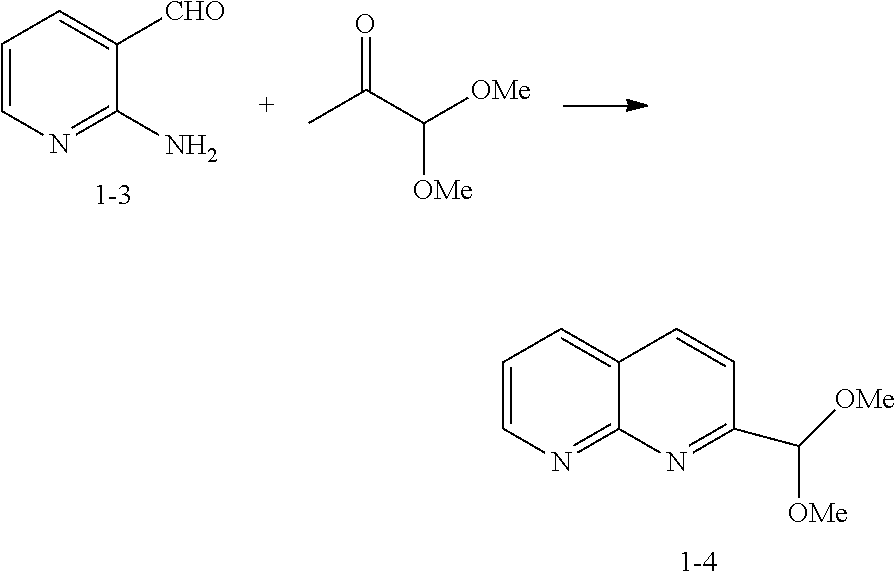Composition and Methods for Treating Chronic Kidney Disease
a technology for chronic kidney disease and composition, applied in the field of composition and methods for treating chronic kidney disease, can solve the problems of increasing the risk of cardiovascular disease, the socio-economic impact of ckd and its complications, and the decline of renal function, so as to improve the glomerular filtration rate, improve the tg and cholesterol, and improve the markers of renal fibrosis.
- Summary
- Abstract
- Description
- Claims
- Application Information
AI Technical Summary
Benefits of technology
Problems solved by technology
Method used
Image
Examples
example 1
Synthesis of Compound A (1-18)
Step A: Preparation of Compound 1-4
[0107]
[0108]To a cold (6° C.) solution of 2-amino-3-formylpyridine 1-3 (40 g, 0.316 mol), ethanol (267 ml), water (41 ml), and pyruvic aldehyde dimethyl acetal (51.3 ml, 0.411 mol) was added 5 M NaOH (82.3 ml, 0.411 mol) at a rate such that the internal temperature was lower than 20° C. After stirring at ambient temperature for 1 hour, the ethanol was removed under vacuum, and iPAc (100 mL) and NaCl (55 g) were added. The layers were separated and the aqueous layer was extracted with iPAc (2×100 ml). The organic layers were combined, filtered through a silica gel bed (90 g), followed by rinse with iPAc (1 L). The fractions were combined and concentrated to 200 ml at 38° C. To the solution was slowly added hexane (400 ml). The resulting suspension was cooled to 10° C. and aged for 30 min before filtration. The suspension was filtered and dried under vacuum to give the product 1-4 (54.2 g; 84%) as colorless crystals; m.p...
example 2
Synthesis of Compound C (2-18)
[0169]
1-Pyridin-3-yl-cyclopropanecarboxylic acid methyl ester (2-2)
[0170]To a cooled (−78° C.) solution of LDA (2.0 M, 272 mL) in 500 mL anhydrous THF and 200 mL HMPA (dried with molecular sieves) was added gradually a solution of ethyl 3-pyridylacetate 2-1 (75.0 g, 454 mmol) in 50 mL THF. The mixture was stirred for 50 min at −78° C. and treated with neat 1,2-dibromoethane (117 mL, 1363 mmol) in one portion. The reaction mixture was stirred overnight while being allowed to warm to room temperature. The reaction mixture was quenched with saturated NH4Cl and extracted three times with EtOAc. The combined organic layers were washed three times with H2O and then brine. After solvent removal, the residue was purified using silica gel chromatography (100% hexanes to EtOAc / hexane=7 / 3) to obtain the desired product 2-2 as an oil.
[0171]1H NMR (400 MHz, CDCl3): δ 8.60 (m, 1H), 8.50 (m, 1H), 7.64 (m, 1H), 7.28 (m, 1H), 4.05 (q, 2H), 1.66 (q, 2H), 1.22 (q, 2H), 1....
example 3
Synthesis of Compound E (3-8)
Step A: 1-(Pyrimidin-5-yl)-7-(5,6,7,8-tetrahydro-[1,8]naphthyridin-2-yl)-hept-1-en-3-one (3-2)
[0201]
[0202]To a stirred suspension of anhydrous lithium chloride (3.54 g, 83.3 mmol) in acetonitrile (350 mL) at room temperature was added a solution of ketophosphonate 3-1 (for preparation of 3-1, see U.S. Pat. No. 6,048,861) (28.3 g, 83.1 mmol) in acetonitrile (128 mL). After stirring for 15 min, a solution of DBU (9.52 mL, 64.1 mmol) in acetonitrile (32 mL) was added to produce a mostly fine white precipitate with some larger masses. The reaction mixture was briefly sonicated to break up the larger masses and stirred for 30 min. A solution of pyrimidine-5-carboxaldehyde (6.92 g, 64.1 mmol) in acetonitrile (128 mL) was added over 15 min. After 2 h, the reaction mixture was filtered and the filtrate concentrated. The residue was purified by flash chromatography (8% MeOH / EtOAc) to give 18.5 g (90%) of enone 3-2 as a yellow crystalline solid; m.p. 101-102° C.
[0...
PUM
| Property | Measurement | Unit |
|---|---|---|
| temperature | aaaaa | aaaaa |
| temperature | aaaaa | aaaaa |
| pH | aaaaa | aaaaa |
Abstract
Description
Claims
Application Information
 Login to View More
Login to View More - R&D
- Intellectual Property
- Life Sciences
- Materials
- Tech Scout
- Unparalleled Data Quality
- Higher Quality Content
- 60% Fewer Hallucinations
Browse by: Latest US Patents, China's latest patents, Technical Efficacy Thesaurus, Application Domain, Technology Topic, Popular Technical Reports.
© 2025 PatSnap. All rights reserved.Legal|Privacy policy|Modern Slavery Act Transparency Statement|Sitemap|About US| Contact US: help@patsnap.com



